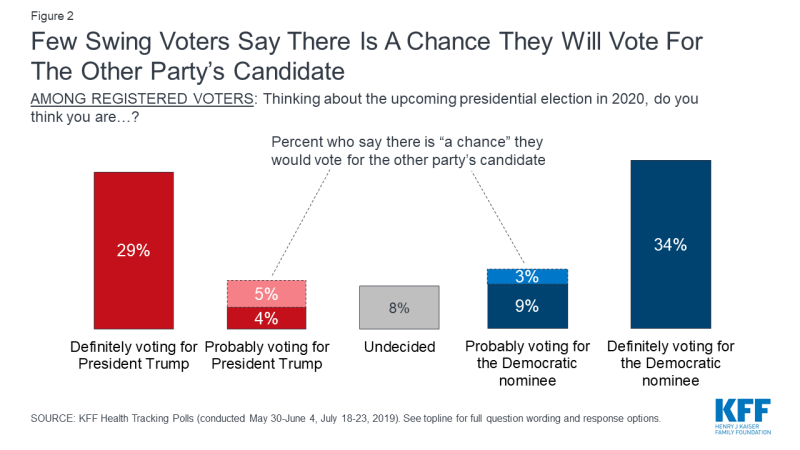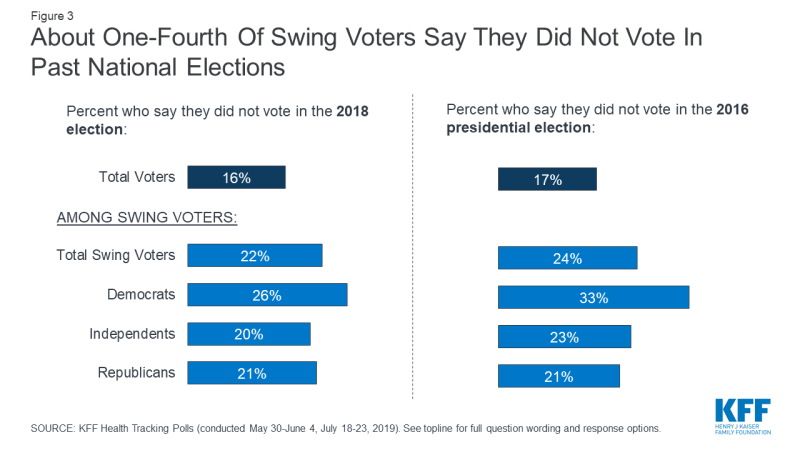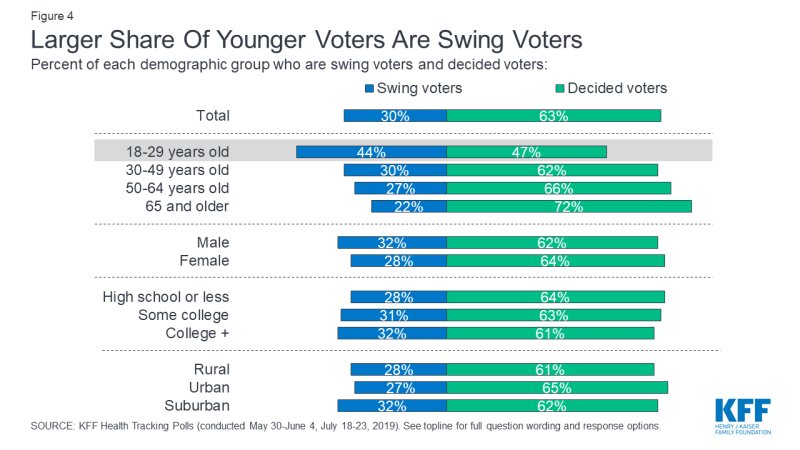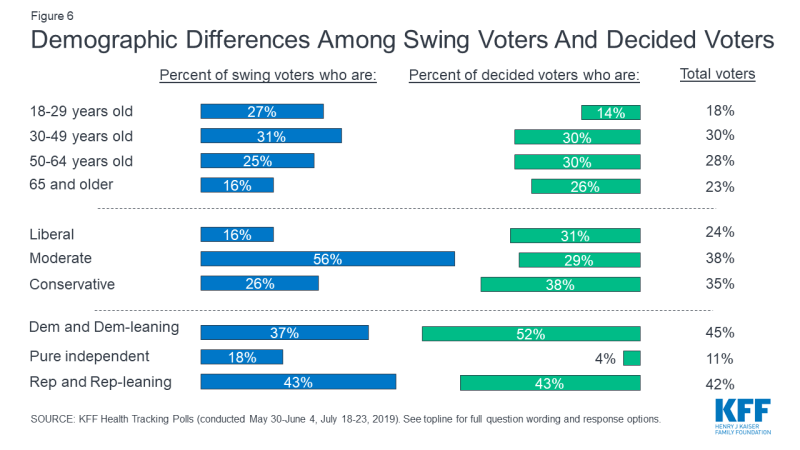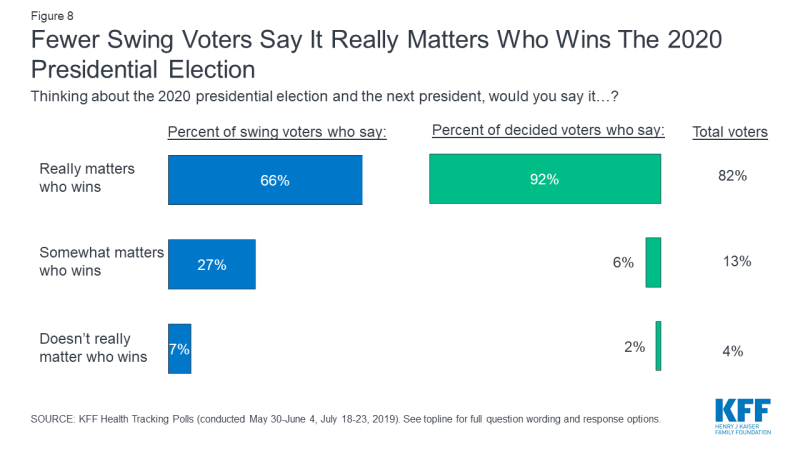Data Note: A Look At Swing Voters Leading Up To The 2020 Election
More than one year out from the general election, there are many factors that could influence voters’ decisions to either vote for President Trump or the Democratic nominee or even stay home on November 3, 2020. These factors include the characteristics of the eventual Democratic nominee, views of President Trump, and how motivated voters are feeling about the election. The latest analysis from the Kaiser Family Foundation, in collaboration with the Cook Political Report, finds that while a large share of voters are already firm about how they plan to vote in the 2020 presidential election (63%), there is a still a substantial share (30%) who say they have not made their minds up. With three in ten votes still up for grabs, this data note examines the demographics of swing voters: those who either report that they are undecided about their vote in 2020 or are leaning towards a candidate but haven’t made up their minds yet. It also explores the policy issues that could swing these voters to vote for either President Trump or the Democratic nominee.
Key Findings
- Three in ten voters are swing voters, meaning they haven’t made up their minds about who they plan to vote for in the 2020 presidential election. While swing voters look similar to their decided counterparts on many demographics, they tend to be younger, more moderate, and less engaged on national politics. Nearly one-fourth of swing voters say they didn’t vote in the 2018 election (22%) or in the 2016 presidential election (24%).
- It is important to note that not all “swing voters” could potentially change their vote to support the other party’s candidate. About half of swing voters (16% of all voters) are truly persuadable. These voters either say they are undecided about who they plan to vote for (8%) or say that while they are probably going to vote for either President Trump or the Democratic nominee, there is a chance they will vote for the other party’s candidate (8%). The other share of swing voters (14% of all voters) say that they are probably going to vote for either President Trump or the Democratic nominee and there is no chance they will vote for the other party’s candidate. While they say there is no chance they will vote for the other party’s candidate, they could choose to not vote at all. In other words, these folks may not change their minds to support another candidate, but if they don’t like what they see from the party they like, they could just stay home.
- Many factors could influence voters’ decisions to either vote for President Trump or the Democratic nominee or even stay home on Election Day. This analysis finds issues like climate change, health care, immigration, or the economy could influence swing voters’ vote choice in 2020. Democrats may have the edge on three issues among swing voters: climate change (38 percentage point advantage), health care (18 percentage points), and immigration (10 percentage points) while President Trump, on the other hand, may have the edge on the economy (12 percentage points). As the 2020 presidential campaign continues, this data indicates that Democrats may benefit more when the focus is on climate change, health care, and immigration, while President Trump may have the advantage on the economy among this group of swing voters. Yet, it is important to note that if the economy slows down significantly, the edge that President Trump has on the economy may dissipate.
- The issue of health care means different things to voters on different sides of the aisle. Nearly half (44%) of swing voters who prefer the Democratic nominee on health care offer responses related to increasing access to health insurance coverage as the reason why they support the Democratic nominee on this issue. Swing voters who prefer President Trump on health care do not appear to be rallying behind a single health care issue but offer varying responses. Lowering the amount people pay for health care ranks high for both sets of swing voters (19% and 16%, respectively).
Who Are The 2020 Swing Voters?
Nearly two-thirds of voters say they have already made up their minds about which candidate they plan to vote for. About one-third of voters (34%) say they are “definitely” going to vote for the Democratic nominee while three in ten (29%) say they are “definitely” going to vote for President Trump. This leaves three in ten voters as the crucial voting block known commonly as “swing voters.” This group of voters either say they are “probably” going to vote for President Trump (9%), “probably” going to vote for the Democratic nominee (13%), or say they are undecided about how they will vote (8%).
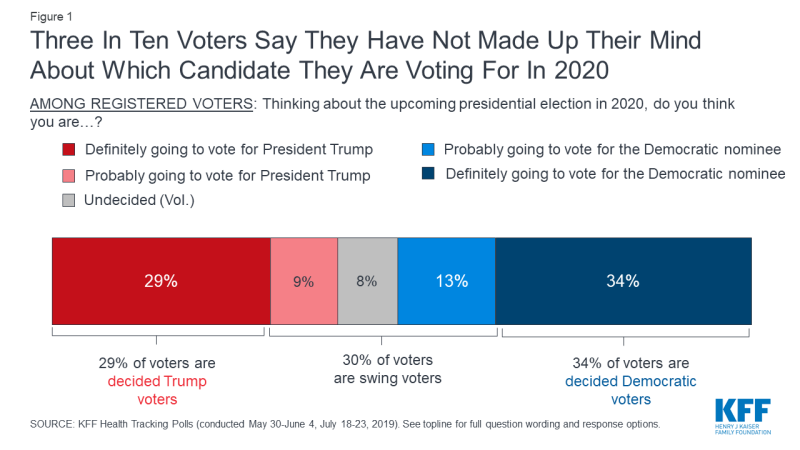
Figure 1: Three In Ten Voters Say They Have Not Made Up Their Mind About Which Candidate They Are Voting For In 2020
It is important to note that not all “swing voters” could potentially change their vote to support the other party’s candidate. Among voters who say they are probably going to vote for either President Trump or the Democratic nominee, few say there is “a chance” they will vote for the other party’s candidate. Among all voters, 5% say they will probably vote for President Trump but there is “a chance” they will vote for the Democratic nominee, while 3% of all voters say they will probably vote for the Democratic candidate but there is “a chance” they will vote for President Trump.
A vast majority of Democratic voters (85%) and most Republican voters (70%) say they aren’t going to cast a vote for the other party’s candidate. Seven in ten voters who identify as Democrats or Democratic-leaning independents say they are “definitely” going to vote for the Democratic nominee and an additional 16% say they are “probably” going to vote for the Democratic nominee and there is “no chance” they will vote for President Trump. On the other side of the aisle, six in ten Republican and Republican-leaning voters say they will “definitely” vote for President Trump with an additional 9% saying they are “probably” going to vote for President Trump and there is “no chance” they will vote for the Democratic nominee.
|
Table 1: Few Voters On Either Side Of Political Aisle Say There Is A Chance They Would Vote For The Other Party’s Candidate |
||||
|
|
Total voters |
Democratic/ Democratic-leaning voters |
Pure independent voters |
Republican and Republican-leaning voters |
|
Definitely voting for President Trump |
29% |
3% |
11% |
61% |
|
Probably going to vote for President Trump |
9 |
1 |
11 |
18 |
|
A chance they will vote for the Democratic nominee |
5 |
1 |
8 |
9 |
|
No chance they will vote for the Democratic nominee |
4 |
* |
3 |
9 |
|
Probably going to vote for the Democratic nominee |
13 |
20 |
11 |
6 |
|
A chance they will vote for President Trump |
3 |
4 |
2 |
3 |
|
No chance they will vote for President Trump |
9 |
16 |
8 |
3 |
|
Definitely voting for the Democratic nominee |
34 |
69 |
13 |
3 |
|
Undecided (Vol.) |
8 |
4 |
29 |
7 |
Instead of voting for the other party’s candidate, some of the voters who are leaning towards a candidate but haven’t made up their minds yet may choose to not vote in the 2020 presidential election. Nearly one-fourth of swing voters say they didn’t vote in either the 2016 presidential election (24%) or in the 2018 election (22%). A slightly larger share of Democrat swing voters (33%) say they didn’t vote in the 2016 election than both independents (23%) or Republicans (21%).
Decided Voters v. Swing Voters
On most demographics, swing voters look very similar to their counterparts (voters who say they have already decided who they are going to vote for in the 2020 election), but they differ on three key variables: age, party identification, and ideology. To see a complete demographic profile of swing voters, see the appendices.
Age
When we look at the share of demographic groups who get classified as either “swing voters” or “decide voters,” we find that about three in ten – across all socioeconomic groups such as gender, education, and urbanicity – are classified as swing voters. This is not true among the different age groups. A larger share of voters between 18 and 29 years old are “swing voters” (44%) which is nearly identical to the share of this group who are “decided voters.”
Party identification and ideology
Perhaps as expected, the decided voters are the more partisan voters with strong ties to party identification and less likely to self-identify as political moderates. Half of political independents have not made up their mind about who to vote for in the 2020 presidential election compared to one-fourth (24%) of Democratic voters and 31% of Republican voters. In addition, four in ten self-identified moderates are classified as “swing voters” which is much larger than the share among those who call themselves liberal (79%) or conservative (70%).
Those with less polarized views of President Trump are also more likely to be classified as “swing voters.” Most of those who either “somewhat approve” (69%) or “somewhat disapprove” (60%) of President Trump are “swing voters,” while majorities of those who either “strongly approve” (85%) or “strongly disapprove” (72%) of President Trump have already made up their minds.
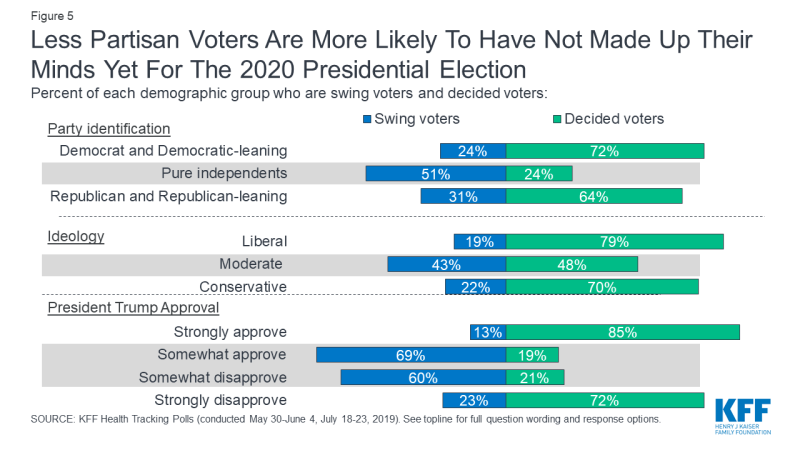
Figure 5: Less Partisan Voters Are More Likely To Have Not Made Up Their Minds Yet For The 2020 Presidential Election
Overall, swing voters tend to be younger: one-fourth are between 18 and 29 years old (27%), compared to 14% of voters who have already decided on their 2020 vote choice. More than half of swing voters (56%) say they have a moderate political ideology, compared to 29% of decided voters; and smaller shares identify as Democrats or Democratic-leaning independents (37% compared to 52%).
Despite the relative similarities between swing voters and decided voters, they behave very differently towards politics and elections. Swing voters are much less likely to say they pay “a lot of attention” to what is going on in national government and politics and much less likely to say the outcome of the presidential election matters a lot than decided voters. On the other hand, voters who have decided they either are going to definitely vote for President Trump or the Democratic nominee are quite similar in how much attention they are currently paying and how important they view the outcome of the presidential election.
About four in ten (39%) of swing voters say they normally pay “a lot” of attention to what is going on in national government and politics compared to a majority of decided voters (68%).
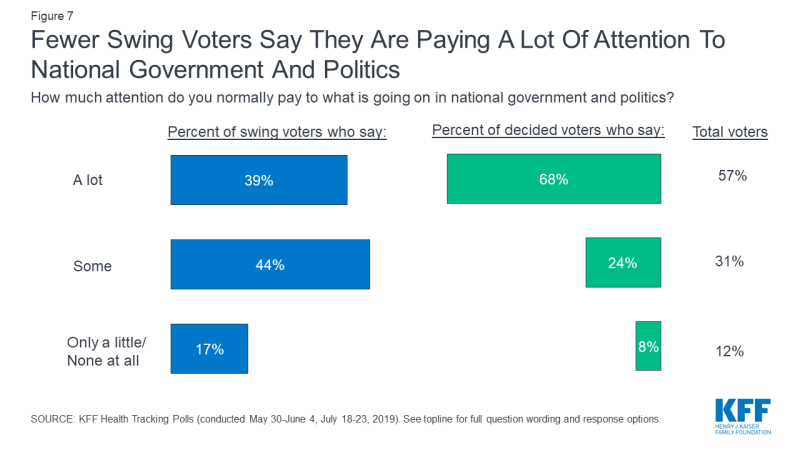
Figure 7: Fewer Swing Voters Say They Are Paying A Lot Of Attention To National Government And Politics
There are no partisan differences among the decided voters with a majority of those who have decided they either are going to definitely vote for President Trump (70%) or the Democratic nominee (66%) saying they normally pay “a lot” of attention to national government and politics.
|
Table 2: Decided Voters, Across Partisanship, Report Paying More Attention To Government And Politics |
||||
|
|
Swing voters |
Decided voters |
Definitely |
Definitely |
|
A lot |
39% |
68% |
70% |
66% |
|
Some |
44 |
24 |
22 |
26 |
|
Only a little/None at all |
17 |
8 |
8 |
8 |
Similarly, swing voters are seemingly less concerned about the outcome of the presidential election. While a majority of swing voters (66%) say it “really matters who wins the 2020 presidential election,” more than one-third of swing voters say that it either “somewhat matters” (27%) or “doesn’t really matter” (7%) who wins the 2020 presidential election. The vast majority of decided voters (92%) say it “really matters who wins the 2020 presidential election.”
Once again, there are no partisan differences among those voters who have decided their 2020 vote choice. Vast majorities of voters who have decided they either are going to definitely vote for President Trump (92%) or the Democratic nominee (93%) say it “really matters who wins” the 2020 presidential election.
|
Table 3: Decided Voters, Across Partisanship, More Likely To Say Presidential Election Outcome Matters |
||||
|
|
Swing voters |
Decided voters |
Definitely |
Definitely |
|
Really matters who wins |
66% |
92% |
92% |
93% |
|
Somewhat matters who wins |
27 |
6 |
6 |
5 |
|
Doesn’t really matter who wins |
7 |
2 |
2 |
2 |
Which Issues Could Swing The Election?
Many factors could influence voters’ decisions to either vote for President Trump or the Democratic nominee or even stay home on Election Day. These include the characteristics of the eventual Democratic nominee, views of President Trump, and how motivated voters are feeling about the election. When swing voters were asked whether a series of different issues could persuade them to vote for President Trump or the Democratic nominee, the latest analysis finds issues like climate change, health care, immigration, or the economy could influence swing voters’ vote choice in 2020.
Democrats have the edge on three issues among swing voters: climate change, health care, and immigration. The Democratic candidate has a 38 percentage point advantage on the issue of climate change with six in ten swing voters (59%) saying the issue of climate change makes them “more likely to vote for the Democratic candidate” compared to 22% who say climate change would make them more likely to vote for President Trump. Similarly, half of swing voters say the issue of health care makes them more likely to vote for the Democratic candidate compared to 32% who say health care would make them more likely to vote for President Trump; giving the Democratic nominee an 18 percentage point advantage on this issue. The Democratic candidate also as a 10 percentage point advantage on immigration (49% v. 40%). This data suggests that during the 2020 presidential race, Democrats may benefit more when the focus is on climate change, health care, and immigration – the three issues that swing voters say could influence them to vote for the Democratic presidential candidate.
President Trump, on the other hand, may have the edge on the economy. Half of swing voters say the economy makes them more likely to vote for President Trump (48%) compared to one-third of swing voters who say it makes them more likely for the Democratic nominee (35%). So if the focus of the 2020 presidential campaign is on the economy, President Trump may have the advantage among swing voters.
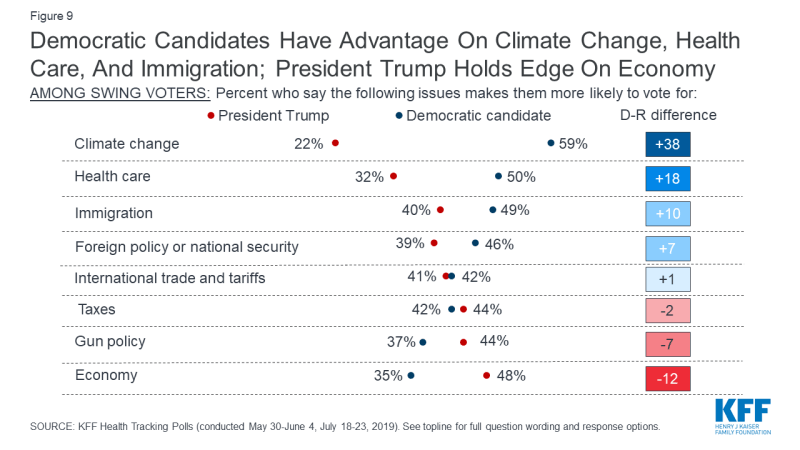
Figure 9: Democratic Candidates Have Advantage On Climate Change, Health Care, And Immigration; President Trump Holds Edge on Economy
For the other issues included in the survey, it is less clear whether President Trump or the Democratic candidate has an advantage. The Democratic candidate has a seven percentage point edge on foreign policy while President Trump has a seven point edge on gun policy1; however these slight advantages are not statistically significant. Similar shares of swing voters say they prefer President Trump or the Democratic nominee on international trade and tariffs and taxes.
Health Care as An Election Issue
When swing voters who say health care is an issue that would make them more likely to vote for Democratic candidate (50% of swing voters) are asked to say in their own words what it is about health care that could influence their vote choice, nearly half (44%) offer responses related to increasing access to health insurance coverage. This is followed by one-fifth (19%) who offer lowering the amount people pay for health care. Fewer offer responses such as: Democrats care more about health care (7%), general opposition to President Trump (7%), or support or protection of the Affordable Care Act (7%).
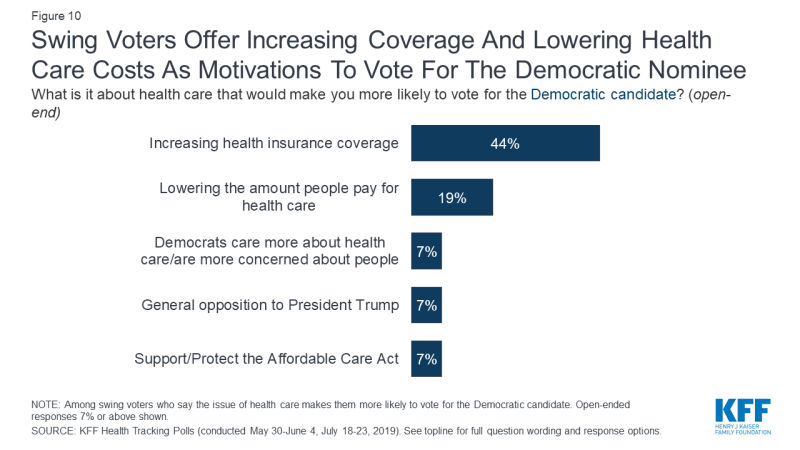
Figure 10: Swing Voters Offer Increasing Coverage and Lowering Health Care Costs As Motivations To Vote For The Democratic Nominee
On the other side of the ballot, when swing voters are asked to say in their own words what it is about health care that would make them more likely to vote for President Trump (32% of swing voters), they offer a variety of health care issues that could influence their vote choice. About one in six of these swing voters say lowering the amount people pay for health care (16%), free market or less government involvement (14%), opposition to the ACA (13%), or opposition to a national health plan or Medicare-for-all plan (12%) make them more likely to vote for President Trump in 2020.
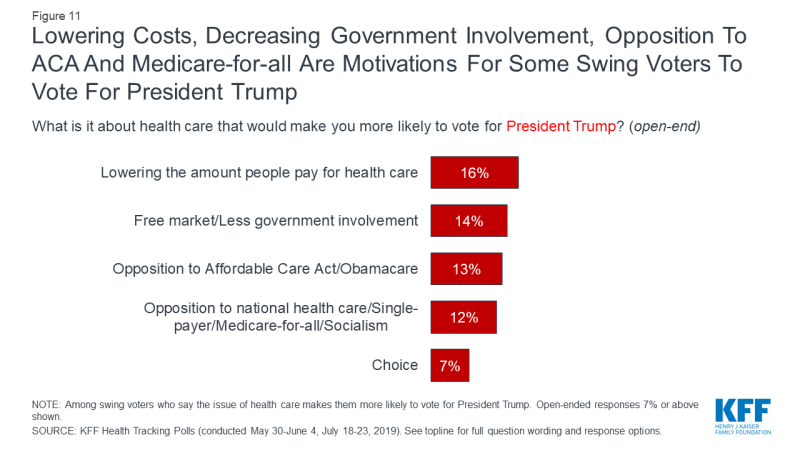
Figure 11: Lowering Costs, Decreasing Government Involvement, Opposition To ACA And Medicare-for-all Are Motivations For Some Swing Voters To Vote For President Trump
Lowering the amount people pay for health care is the only health care issue that was offered by substantial shares of both swing voters who say the issue of health care makes them more likely to support President Trump (16%) and those who say it makes them more likely to vote for the Democratic nominee (19%).

